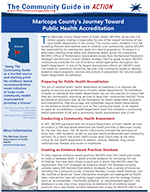Maricopa County’s Journey Toward Public Health Accreditation
Summary
 The Maricopa County Department of Public Health serves over 3.8 million people, making it responsible for one of the largest territories of any local health department in the country. In one of their largest improvement efforts yet, they used The Community Guide to identify evidence-based programs, services, and policies in preparation for national public health department accreditation. (Released 2014)
The Maricopa County Department of Public Health serves over 3.8 million people, making it responsible for one of the largest territories of any local health department in the country. In one of their largest improvement efforts yet, they used The Community Guide to identify evidence-based programs, services, and policies in preparation for national public health department accreditation. (Released 2014)Lessons Learned
- Use The Community Guide to Fill Gaps in Public Health Tools. Maricopa County employed an innovative approach to assessing and cataloguing evidence-based strategies in public health. By using The Community Guide as a basis for a database of evidence-based strategies, this public health tool became an underpinning to their community health improvement plan.
- Engage Partners for Success. Stakeholders and partners can provide different perspectives to address issues and can be valuable resources for public health departments. By engaging voluntary partners from multiple sectors, MCDPH was able to build momentum toward a meaningful CHIP, thereby increasing trust among its constituents.
- Organized Evidence-Based Approaches can Ease Future Program Implementation. By being able to find evidence-based intervention strategies in one place, the program staff was able to integrate programmatic needs with CHIP requirements. This helped to create dialogue and planning between different types of health department staff. Because of increased communication, MCDPH was able to organize their CHIP along established criteria, rather than having to start a program from scratch.
Story
Preparing for Public Health Accreditation
The aim of national public health department accreditation is to improve the quality of practice and performance of public health departments.4 Accreditation is based on standards that health departments can put into practice to ensure that they are continuously improving services to keep their communities healthy.4 Since accreditation processes help lay the foundation for health department programs and interventions, they encourage, and sometimes require health departments to use evidence-based resources, such as The Community Guide. To be eligible to apply for accreditation, a health department must first complete a community health assessment (CHA) and a community health improvement plan (CHIP).
Conducting a Community Health Assessment
In 2011, MCDPH partnered with the Arizona Department of Public Health Services to conduct a CHA that would determine the health priorities in Maricopa County for the next five years. This 18-month CHA process involved the assistance of more than 1,000 residents, as well as multiple health professionals and community partners. As a result, five public health issues were clearly seen as the most critical for the health department to address: obesity, diabetes, lung cancer, cardiovascular disease, and access to healthcare.
Creating an Evidence-Based Practices Database
To help organize evidence-based practices, MCDPH used The Community Guide to create a database which 1) would provide guidance for increasing the use of findings that have been shown to work and 2) would help MCDPH meet the requirement that CHIP strategies be evidence-based. The database currently contains nearly 800 itemized intervention strategies from a variety of resources, including The Community Guide, Cochrane Reviews, County Health Rankings, and the Institute of Medicine. These intervention strategies are catalogued by health topic, intervention type and setting, target population, and the strategy finding (such as’recommended,’ ‘insufficient evidence,’ or ‘recommended against’). The database is a one-stop-shop, organizing an extensive list of evidence-based practices into a searchable, sortable database that is easy for MCDPH staff to use.
Developing the Maricopa County CHIP
Using the results of the CHA and the evidence-based practices database, MCDPH began drafting a five-year CHIP for Maricopa County. The CHIP emphasized the five public health priority areas (obesity, diabetes, lung cancer, cardiovascular disease, and access to healthcare) where MCDPH and its partners could have the greatest impact in improving the quality of life for all Maricopa County residents.
The MCDPH CHIP followed Arizona’s Chronic Disease Strategic Plan4 and the National Prevention Strategy2 by directing prevention strategies for improving health at the community level across four sectors: Where We Live (community), Where We Work (worksites), Where We Learn (education), and Where We Seek Care (healthcare). MCDPH formed workgroups of volunteers to develop strategies and activities for the five health priority areas in each of the community sectors. The volunteers were experts in policy, evaluation, communication, and epidemiology from public and private organizations, employers, and non-profit agencies representing all four community sectors. MCDPH was able to identify the sectors deemed most important by gauging volunteers’ participation level, which allowed MCDPH to focus energy where the community wanted it most.
Next Steps
The first step in applying for public health accreditation involves submitting a letter of intent for accreditation approval. The MCDPH has submitted its letter of intent to the Public Health Accreditation Board and will be submitting their accreditation application in the spring of 2014. Once the accreditation application has been approved, MCDPH intends to use evidence from The Community Guide listed in the MCDPH database in planning for evaluation of their implemented CHIP.
1 U.S. Census Bureau. Retrieved January 2014. http://www.census.gov.
2 National Prevention Strategy. Retrieved December 2013. www.surgeongeneral.gov/initiatives/prevention/strategy/report.pdf.
3 Arizona Chronic Disease Strategic Plan 2012-2015. Retrieved December 2013.www.arizonahealthmatters.org/javascript/htmleditor/uploads/maricopa/reports/az-chronic-disease-strategic-plan-2012-2015.pdf.
4 Public Health Accreditation Board. Guide to National Public Health Department Accreditation. Version 1.0. May 2011. www.phaboard.org/wp-content/uploads/PHAB-Standards-and-Measures-Version-1.01.pdf.